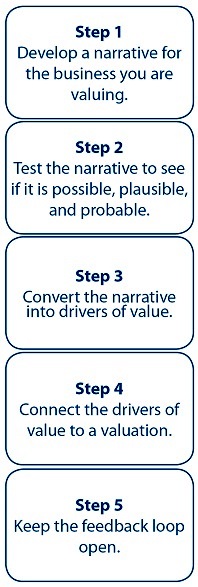 Aswath Damodaran addressed CFA members in a talk on valuation in Singapore on 23 May 2017 (Photo by Sim Kih) Aswath Damodaran addressed CFA members in a talk on valuation in Singapore on 23 May 2017 (Photo by Sim Kih)
Professor Aswath Damodaran, the celebrated author of several widely used academic and practitioner texts on valuation, corporate finance, and investment management, illustrated his 5-step approach to valuing Uber in his address to CFA members on how every number in a valuation model is to be backed up by a story. |
The way to think about valuation is: It is a bridge between stories and numbers.
Good Valuation
If I ask you, “Why is the revenue in your forecast $60 billion?”
Here is the answer I don’t want to hear: “Because I used 15% for revenue growth in the first five years, and 5% for the next five.”
I want to hear what you know about the company that justifies a $60 billion revenue. Every number in your valuation has to be backed up by a story. Conversely, every story about how great the company is has to be backed up by a number.
- Aswath Damodaran Professor of Finance |
Number crunchers tend to have the following delusions:
- Delusion of precision: When in doubt, add decimals – makes us feel more ‘precise’.
- Delusion of being objective: I’m just using numbers. How can I be biased?
- Delusion of being in control: I’m in control because I’ve put in numbers.
- Contempt for number crunchers: Number crunchers are boring people who don’t dream in color.
- Great believers in the anecdote: If I tell a really good story, I will be rewarded with a multi-billion dollar value. A sample size of one can be generalized to the entire universe.
- Story tellers tend to have the following delusions:
- Left to our own devices, chances are we will find and stay in our own delusions.
5-step Process to Valuation
Step 1: Develop a narrative for the business you are valuing
In every company I value, the first thing I do is: I tell a story about the company. Before I open my spreadsheet, I first have to get my story straight before I put a number down.
Uber Example
Uber is probably the most valuable private company today. It has a valuation of US$71 billion. I first heard about Uber when I read a Wall Street Journal article in 2014 that said venture capitalists had priced Uber at US$17 billion.
| ♦ Things to Find Out |
|
Step 2: Test the narrative to see if it is possible, plausible, and probable
|
♦ Talk to People who Use the Service |
|
In 2014, intrigued by a news report on Uber’s huge valuation, the Professor downloaded the Uber app onto his smartphone, called a cab, and asked the driver to drive him around for half an hour so that he could ask some questions. |
There are lots of possible narratives, not all of them are plausible, and only a few of them are probable. Don’t base your valuation input on a fairy tale story.
For example, it is impossible for a company’s revenue to grow so much that it has more than a 100% market share. It is also impossible for earnings growth to exceed revenue growth for long enough that profit margin eventually exceeds 100%. It is implausible that a company grows and earns higher profits without competition. It is also implausible that it generates high returns with no risk.
It is improbable that a company has high growth with low reinvestment needs.
Step 3: Convert the narrative into drivers of value
The third step is where the craft of valuation comes in. Check the narrative against history, economic first principles, and common sense. Take the narrative apart and look at how you will bring it into valuation inputs starting with potential market size down to cash flows and risk.
By the time you are done, each part of the narrative should have a place in your numbers and each number should be backed up by a portion of your story.
What if I come to a part of a story that I cannot convert into a number? I firmly believe that no matter how fuzzy your story seems, you can convert it into a number. You just haven’t tried hard enough.
Step 4: Connect the drivers of value to a valuation
Once you convert each part of your story into inputs for your valuation, your valuation will emerge. Create an intrinsic valuation model that connects the inputs to an end-value in the business.
When you come to step four, you should seek out people who are most likely to disagree with you. Don’t let your defense mechanisms kick in too soon.
Instead of thinking: How dare you criticize my cost of capital!
Think: There’s someone out there who knows more about this than I do, and I’m going to find that person. Before you start on the valuation process, you have to understand the company and the businesses.
Unfortunately, some people restrict their valuation process to getting templates and going through the financial statements. The way to understand a company is to talk to people who use the products and services of the business.
Step 5: Keep the feedback loop open
Face up to the uncertainty in your own estimates of value. Create a process where people who disagree with you the most have a say. Provide a structure where the criticisms can be specific and pointed, rather than general. Listen to people who know the business better than you do and use their suggestions to fine tune your narrative and perhaps even alter it. Work out the effects on value of alternative narratives for the company.
Listen to people who know the business better than you do and use their suggestions to fine tune your narrative and perhaps even alter it. Work out the effects on value of alternative narratives for the company.
Bill Gurley, partner of Benchmark Capital, one of the first venture capital companies to invest in Uber (with a US$2 billion valuation), is on Uber’s board of directors. Obviously, he knew more about Uber than I do.
He sent me an email that said, ‘I read your blog on how you valued Uber and I did not like it. I put up a blog post to counter your blog post.’ I went to Bill Gurley’s blog, Above the Crowd. His post said: “Uber is not a car service company. It is a logistics services company.”
By using the word logistics, he expanded the potential market to car service delivery and moving. He said Uber can create new demand for car service in parts of the country where taxis are not used including suburbia and small towns.
He said that they are converting their local networking benefits to global benefits. The next time you make a flight reservation on United Airlines, you will get an option that says, “Get me an Uber car when I land in Singapore.” By linking with technology and credit card companies, Uber can have global networking benefits.
I was fascinated by the story. After I read the story, I took my US$100 billion market and made it US$300 billion to include logistics services. I took my 10% market share and made it 40% to extend local networking benefits to global. My valuation of US$6 billion went to US$53 billion.
I emailed the revised valuation to him and asked, “Do you like it?”
“I like it a lot. By the way, we’re going to lower the 80:20 revenue split to 90:10,” he said. I went to my spreadsheet and changed it to 90:10 and came up with a valuation of US$29 billion. Every time I value a company and someone comes up with a much higher valuation than I do, it’s not my business to step in and say that valuation doesn’t make sense. It doesn’t make sense to me, but I can’t generalize that into: It doesn’t make sense to anybody.
|
Input |
June 2014 |
September 2015 |
Rationale |
|
Total Market |
US$100 billion |
US$230 billion |
Market is broader, bigger, and more global than I thought it would be. Uber’s entry into delivery and moving businesses is now plausible, perhaps even probable. |
|
Growth in Market |
Increase maret size by 34%; |
Double market size; CAGR of 10.39%. |
New customers being drawn to car sharing, with more diverse offerings. |
|
Market Share |
10% (local networking) |
25% (weak global networking) |
Higher cost of entry will reduce competitors, but remaining competitors have access to capital. In Asia, they have hometown advantage. |
|
Slice of Gross Receipts |
20% (left at status quo) |
15% |
Increased competiton will reduce car service company slice. |
|
Operating Margin |
40% (low cost model) |
25% (partial employee model) |
Dirvers will become partial employees, higher insurance and regulatory costs. |
|
Cost of Capital |
12% (ninth decile of US companies) |
10% (75th percentile of US companies) |
Business model in place and substantial revenues. |
|
Probability of Failure |
10% |
0% |
Enough cash on hand to fend off threats to survival. |
|
Value of Equity |
US$5.9 billion |
US$23.4 billion |
Value increased more than four fold. |
Table: Damodaran’s assumptions for valuing Uber
|
We are missing the point when we argue over the revenue growth rate over the next 5 years. Your argument should be about the vision for the company and which vision is more probable and plausible. Why argue over beta or cost of capital, especially over numbers which are not on the top 10 list of things that drive the valuation? |


